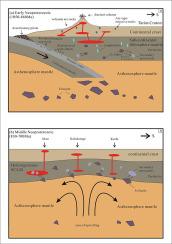当前位置:
X-MOL 学术
›
J. Asian Earth Sci.
›
论文详情
Our official English website, www.x-mol.net, welcomes your
feedback! (Note: you will need to create a separate account there.)
Ferrodoleritic dykes in the Tarim Craton signal Neoproterozoic breakup of Rodinia supercontinent
Journal of Asian Earth Sciences ( IF 2.7 ) Pub Date : 2020-09-01 , DOI: 10.1016/j.jseaes.2020.104476 Hengxu Li , Zhaochong Zhang , M. Santosh , Zhenchao Wang , Shengkai Jin , Qiang Zhang , Linghan Liu
Journal of Asian Earth Sciences ( IF 2.7 ) Pub Date : 2020-09-01 , DOI: 10.1016/j.jseaes.2020.104476 Hengxu Li , Zhaochong Zhang , M. Santosh , Zhenchao Wang , Shengkai Jin , Qiang Zhang , Linghan Liu

|
Abstract Mafic dyke swarms are important bar codes for the rifting and breakup of supercontinents. Here we report a Neoproterozoic mafic (ferrodoleritic) dyke swarm from the Aksu area along the northern margin of the Tarim Craton, NW China. Zircon U-Pb analyses of two dyke samples yielded ages of 801 ± 9 Ma and 804 ± 13 Ma. The ferrodoleritic dykes show high total FeO (11.55–14.55 wt%) and TiO2 contents (2.84–3.26 wt%) and variable SiO2 (47.90–52.74 wt%). They display positive anomalies of Rb, Ba, K and negative anomalies of Nb, Ta, Ti and the enrichment of light rare earth elements relative to heavy rare earth elements. The whole-rock eNd(t) values (–5.4 to –7.2) indicate a relatively homogeneous and enriched magma source. Trace element modelling suggests that the ferrodoleritic dykes were generated by low degree of partial melting (garnet lherzolite 3–5%, pyroxenite 5–10%) of a mixed mantle source (60% garnet lherzolite and 40% pyroxenite). The results from our study suggest two major mafic magma pulses at ca. 830–800 Ma and ca. 780–750 Ma during the Neoproterozoic, which we correlate to the onset of Rodinia supercontinent breakup.
更新日期:2020-09-01











































 京公网安备 11010802027423号
京公网安备 11010802027423号